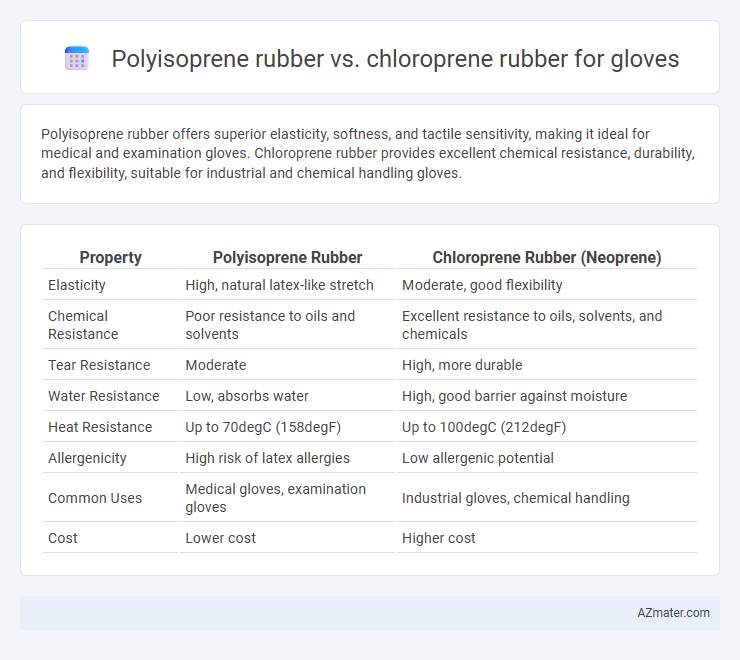Polyisoprene rubber offers superior elasticity, softness, and tactile sensitivity, making it ideal for medical and examination gloves. Chloroprene rubber provides excellent chemical resistance, durability, and flexibility, suitable for industrial and chemical handling gloves.
Table of Comparison
| Property | Polyisoprene Rubber | Chloroprene Rubber (Neoprene) |
|---|---|---|
| Elasticity | High, natural latex-like stretch | Moderate, good flexibility |
| Chemical Resistance | Poor resistance to oils and solvents | Excellent resistance to oils, solvents, and chemicals |
| Tear Resistance | Moderate | High, more durable |
| Water Resistance | Low, absorbs water | High, good barrier against moisture |
| Heat Resistance | Up to 70degC (158degF) | Up to 100degC (212degF) |
| Allergenicity | High risk of latex allergies | Low allergenic potential |
| Common Uses | Medical gloves, examination gloves | Industrial gloves, chemical handling |
| Cost | Lower cost | Higher cost |
Introduction to Polyisoprene and Chloroprene Rubber
Polyisoprene rubber, a natural latex material, offers excellent elasticity, comfort, and tactile sensitivity, making it ideal for medical and surgical gloves. Chloroprene rubber, also known as neoprene, provides superior chemical resistance, durability, and protection against oils and solvents, commonly used in industrial gloves. Both materials deliver unique performance benefits, with polyisoprene emphasizing natural feel and chloroprene excelling in protective applications.
Chemical Structure and Composition Comparison
Polyisoprene rubber, a natural polymer composed primarily of cis-1,4-polyisoprene units, exhibits high elasticity and tensile strength due to its long, linear chains with minimal crosslinking. Chloroprene rubber, a synthetic polymer made from polymerized chloroprene monomers, incorporates chlorine atoms that enhance chemical resistance, flame retardancy, and weatherability. The presence of chlorine in chloroprene alters its molecular polarity and crosslink density, resulting in greater durability against oils, solvents, and environmental degradation compared to the predominantly hydrocarbon-based polyisoprene.
Manufacturing Processes of Polyisoprene vs Chloroprene Gloves
Polyisoprene gloves are typically manufactured using the dipping process where liquid polyisoprene latex is coagulated on ceramic hand molds, offering superior elasticity and softness similar to natural rubber. Chloroprene gloves production also involves the dipping method but utilizes synthetic polychloroprene latex, which provides enhanced chemical resistance and durability. The curing process for polyisoprene involves vulcanization with sulfur, while chloroprene gloves undergo a specific chlorination step to improve surface properties and chemical stability.
Physical and Mechanical Properties
Polyisoprene rubber offers excellent elasticity and tensile strength, making it highly flexible and comfortable for glove applications requiring precise dexterity. Chloroprene rubber exhibits superior resistance to abrasion, chemicals, and weathering, providing enhanced durability and mechanical robustness for industrial glove use. The choice between polyisoprene and chloroprene gloves depends on the specific balance needed between flexibility and resistance to harsh environmental factors.
Allergenicity and Skin Sensitivity
Polyisoprene rubber gloves exhibit low allergenicity, making them suitable for individuals with latex allergies due to the absence of natural latex proteins, reducing the risk of skin sensitivity and allergic reactions. Chloroprene rubber gloves also offer hypoallergenic properties, with minimal risk of causing skin irritation or allergic contact dermatitis, as they lack the natural latex proteins found in traditional latex gloves. Both materials provide effective alternatives for sensitive skin, but polyisoprene is often preferred for its closer latex-like feel and reduced potential for allergic responses.
Chemical and Biological Resistance
Polyisoprene rubber gloves offer excellent flexibility and comfort but have limited chemical resistance, particularly against oils, solvents, and petroleum-based products. Chloroprene rubber gloves provide superior resistance to a broad spectrum of chemicals, including acids, alkalis, alcohols, and certain hydrocarbons, alongside strong biological resistance to bacteria, fungi, and viruses. For applications requiring enhanced protection against chemical exposure and infectious agents, chloroprene gloves are generally preferred over polyisoprene alternatives.
Comfort, Fit, and Tactile Sensitivity
Polyisoprene rubber gloves offer superior comfort and a natural fit due to their soft, elastic properties that closely mimic human skin, enhancing tactile sensitivity for delicate tasks. Chloroprene rubber gloves provide excellent durability and chemical resistance but tend to be less flexible, resulting in a slightly reduced fit and tactile feedback compared to polyisoprene. For applications requiring prolonged wear and precision, polyisoprene gloves are generally preferred, while chloroprene gloves are chosen when chemical protection is a priority.
Cost-Effectiveness Analysis
Polyisoprene rubber gloves provide excellent elasticity and comfort similar to natural latex but at a generally lower cost compared to chloroprene rubber gloves, making them a cost-effective choice for disposable gloves in medical and industrial use. Chloroprene rubber gloves offer superior chemical resistance and durability, justifying higher costs for applications requiring prolonged exposure to harsh chemicals or physical abrasion. Evaluating cost-effectiveness depends on the specific glove usage scenario, with polyisoprene preferred for short-term, budget-sensitive tasks, while chloroprene is optimal for demanding environments where glove longevity and protection reduce replacement frequency and overall expenses.
Common Applications in Glove Industry
Polyisoprene rubber gloves are widely used in the medical and surgical sectors due to their excellent elasticity, comfort, and high tactile sensitivity, making them ideal for tasks requiring precision. Chloroprene rubber gloves offer superior chemical and abrasion resistance, making them suitable for industrial applications such as automotive, chemical handling, and food processing where durability and protection against oils and solvents are critical. Both materials provide effective alternatives to natural rubber latex, catering to different glove industry demands based on their specific performance characteristics.
Choosing the Right Glove: Polyisoprene or Chloroprene?
Polyisoprene rubber gloves offer excellent elasticity, softness, and a natural feel, making them ideal for users with latex allergies while maintaining high tactile sensitivity. Chloroprene rubber gloves provide superior chemical resistance, durability, and protection against oils, solvents, and certain hazardous materials, suitable for industrial and laboratory environments. Choosing the right glove depends on the application's required chemical resistance, comfort, and potential allergy considerations, with polyisoprene preferred for sensitive skin and chloroprene for robust protection.

Infographic: Polyisoprene rubber vs Chloroprene rubber for Glove
 azmater.com
azmater.com